Reply To:
Name - Reply Comment
Last Updated : 2024-04-26 06:31:00
Sri Lanka, over the years, has tainted its reputation in risk-reduction in the face of disasters. Events that unfolded following the floods and landslides in the past few years bear testimony to this. While there is no force that can counter the power of nature, the tragedy that struck Meethotamulla last week was entirely the result of our own actions. Last year, the floods in Sri Lanka exposed the weaknesses of government authorities in the mitigation of risk factors and crisis management. As government authorities struggled with the devastation, citizen’s initiatives used social media as an instant and effective communication and coordination tool, managing a disastrous situation and painting government efforts in a poor light.
The catastrophe in Meethotamulla was no different, as government efforts were dubbed ‘too little, too late’ by the public. The Dailymirror set out to investigate the government’s efforts in formulating the way forward as it grapples with a long-ignored waste management crisis. Our continued efforts to contact Colombo Municipal Council Commissioner V.K. Anura, to verify the CMC’s plans to resolve the garbage disposal issue failed. However, Western Province Waste Management Authority Director Nalin Mannapperuma said the garbage disposal issue was aggravated due to improper segregation of waste by people, adding that a solution to the garbage issue in the Western Province required the assistance of the public.
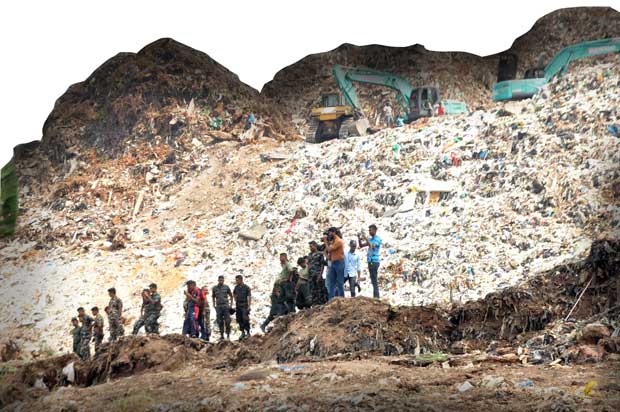
The blame game
As protests erupted in several areas across the Western Province, attempts by the various urban and municipal councils in the province to be relieved of their daily collections of rotting waste were thwarted. Tense situations were reported in Kalagedihena, Kotikawatte and Karadiyana, where residents staged protests against the decision to dump garbage in the dump sites of these respective areas. Protesters had obstructed traffic, fearing that garbage from other areas would be dumped in the vicinities of their residences.
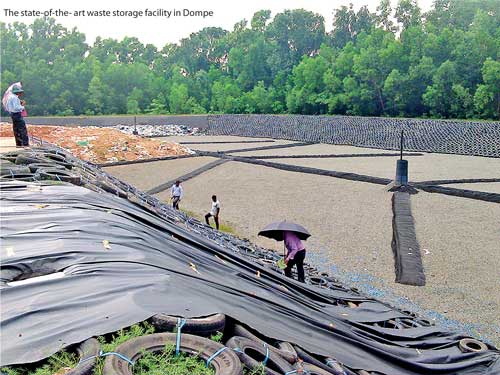
The unfolding drama escalated when Western Province Chief Minister Isura Devapriya said he had not been informed of the decision to temporarily dump garbage collected in Colombo at the Karadiyana garbage dump site, in an ongoing blame game between himself and Megapolis and Western Development Minister Patali Champika Ranawaka. The Kesbewa Magistrate issued a court order on April 17 to temporarily divert garbage previously being dumped in Meethotamulla to the dumpsite at Karadiyana. Addressing a media briefing, Chief Minister Devapriya said he was not interested in a tug-of-war but said the issues surrounding waste management in the Western Province would be solved promptly. He assured the Karadiyana residents that these were only emergency measures.

Meanwhile, at a press briefing held yesterday, Megapolis and Western Development Minister Patali Champika Ranawaka said it was the responsibility of the urban and municipal councils to find a solution to this problem. “Currently, close to 600-800 tonnes of garbage is collected daily from Colombo, while 1,600-2,000 tonnes is collected from the Western Province. The Aruwakkalu project is a good initiative but it will take close to two years to commence the project,” he said.
Waste energy projects will take 2-3 years to materialize:

Dr. Mahesh Jayaweera
In his comments with regard to this incident, Senior Lecturer, Department of Civil Engineering, University of Moratuwa Dr. Mahesh Jayaweera who is also overlooking the ‘Technical Aspect of the Stabilisation of Meethotamulla Garbage dump’, said 12 steps had been identified as practical solutions to the issue of dumping garbage. “This project is being conducted by the Megapolis and Western Development Ministry and the plan was presented to the President yesterday. A team from the World Bank too has extended its support to implement this plan and initiate a practical solution to this garbage problem. The proposed plan to establish a sanitary landfill site in Meepe back in 1990 was abandoned due to political pressure. So far, there are three waste energy projects in the pipeline but this will take two to three years to materialize. In the meantime, the Megapolis Ministry is working on the Aruwakkalu sanitary landfill site project as well,” Dr. Jayaweera said.
Foreign Funding for Waste Management
The Dailymirror learned that there had been numerous proposals over the years from foreign donors to aid and establish a sustainable waste management process in Sri Lanka. Despite our efforts however, we were only able to verify the aids and loan facilities granted by South Korea, the results of which were yet to be witnessed.

In December 2011, the Korean Government provided a USD 4.5 million grant to improve waste management in the country. The money was to be used to build a state-of-the-art waste storage in Dompe in the Gampaha district. Using the grant, measures were to be taken to improve compost production and the use of recycled waste in building parks and similar areas.
In March 2014, in response to a priority environmental issue of open dumping of solid waste, a pilot project for the “Establishment of Integrated Waste Management System” had been introduced at the Dompe Pradeshiya Sabha in the Gampaha District by the Korea International Cooperation Agency (KOICA), the Korean Government’s grant aid agency.
The sanitary solid waste disposal system was to adopt technically advanced methods that were successfully used in Korea. This system was aimed at providing an improved hygienic environment to enhance the living standards of citizens and to also help mitigate environmental pollution and secure soil and water systems from contamination that increasingly challenged public health and development goals. After four years of construction, the system kicked off its operations on November 27, 2014 at Maligawatta in Dompe. According to KOICA, the 20,000-square-metre landfill in Dompe has a capacity to manage 90 tonnes of solid waste per day.
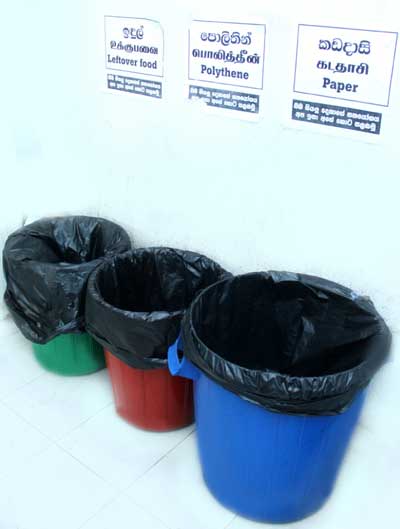
Also in July 2014, the Korean Government agreed to provide financial assistance of USD 34 million of the total cost of USD 42 million to establish four sanitary solid waste disposal facilities through the Economic Development Cooperation Fund (EDCF) of the Export Import Bank of Korea (KEXIM). The financial assistance is used to control the deteriorating environmental conditions around roadsides, swamps and lowlands, and the GoSL is to implement ‘Pilisaru’ (recycling resources) and an Integrated Sustainable Waste Management Programme (ISWMP). The construction of the four disposals have been implemented in Anuradhapura, Galle, Jaffna and Pollonnaruwa districts under the above programme.
The above facts have been confirmed by the country director of KOICA and the Korean Exim Bank.
The Daily Mirror further learns from a trusted source that a waste management project that was to be conducted in Kolonnawa with foreign assistance was cancelled due to unknown reasons.
CMC’s Plans not clear:
Deputy Director General Waste Management, Central Environment Authority, Upali Indrarathna
“We are not sure of the Colombo Municipal Council’s (CMC) future plans on waste management as they have not submitted any proposals to us. They have requested some facilities from our Dompe  sanitary landfill to get rid of this emergency situation but have not informed us of any future plans as such. We are accepting a daily amount of 90 tonnes of waste in this landfill,” Indrarathna said.
sanitary landfill to get rid of this emergency situation but have not informed us of any future plans as such. We are accepting a daily amount of 90 tonnes of waste in this landfill,” Indrarathna said.
More Sanitary Landfills to Come
Speaking of the construction of future sanitary landfills he said, “At this moment this is the only sanitary landfill in Sri Lanka. All other ‘landfills’ are open dumps. We are working on four more landfills based in four districts, mainly in Jaffna, Galle, Anuradhapura and Polonnaruwa under the Korean Exim Bank loan facility. We hope to begin the process by August or September this year and we expect its conclusion by September 2020. In the meantime, we have forwarded three proposals to the treasury of the Finance Ministry for financial support for the next year for another three landfills which will be based in Gampaha, Ratnapura and Moneragala.”
Dumped altogether
He further stated that if Sri Lanka were to follow a proper waste management system, at least 70% of the waste could be either composted or recycled.
“The first thing we need to do is reduce the garbage; without reducing it we have no options. However, as far as the CMC is concerned, they have not been involved in any proper waste management programme, they have just collected the garbage and dumped it.
There is no proper segregation, recycling or composting programmes. 40% of the total waste we create is compostable- market waste, food waste, kitchen waste, yard waste and other degradable material. The CMC has not made a single effort to compost this huge garbage dump. They have merely collected all this garbage and sent it to Meethotamulla.”
“The CMC started conducting this segregation programme but they haven’t been doing it properly. They have implemented part of it and are collecting segregated waste from houses and other places, however the total waste goes to the garbage dump.
They are getting the waste separately and depositing it at the garbage dump, altogether.
With the segregation of waste, at least 40% will go towards composting and another 30% should go for recycling.
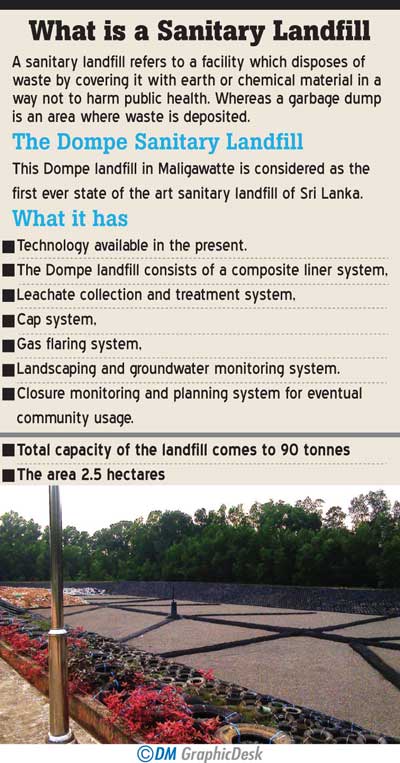
The balance 30% that remains can be easily managed by having a landfill or through incineration. If we encourage and continue this separation and recycling, then that 30% can be reduced to 25% even, which is a small amount.”
“Collecting garbage like this creates numerous environmental issues and is damaging to the surroundings. Certain liquid and gas emissions are dangerous to both the people and the environment. These are created by compostable garbage. First of all, we have to bring about a reduction of garbage. What we have now is not a good practice,” he added.
Stuck in Paperwork
Mr. Indrarathna went onto say that they were in the process of starting three waste-to-energy projects. “Turning waste into fuel is a very interesting way to manage waste, however the plans to do this are very costly. Right now, the Megapolis and Western Development Ministry have signed 3 contracts with three private parties to put up waste-to-energy projects earlier this year.
Two will be based in Muthurajawela and one in Karadiyana. One proposal is for 400MT of CMC waste, which will be situated in Muthurajawela, another which will also be situated in Muthurajawela will be for 500 MT of waste from the Gampaha District and the one based in Karadiyana is for local authorities of the Colombo district except for the CMC.
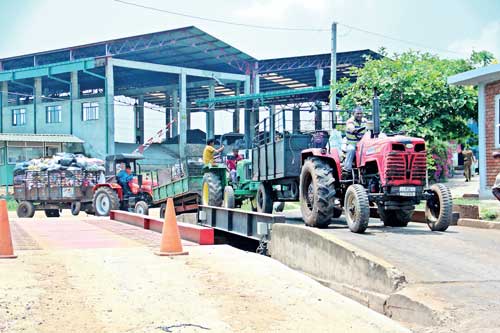
It will take at least 2 years to complete and accept the waste. However, these projects are still under the environmental evaluation stage. Once the Environment Impact Assessment (EIA) report has been submitted, the CEA can issue the clearances immediately. However, the process is being delayed by the project proponent side.
The sooner the EIA is submitted, the sooner we can give the approval. Then again it will take two years to finish the project and to start accepting the waste.”
The Dompe Sanitary Landfill
The Dompe landfill in Maligawatte is considered the first ever state-of-the-art sanitary landfill in Sri Lanka, as it has the highest level of technology available at present. A wide extent of the land had been excavated into a pit which is called a cell, laid with layers of different material to protect the soil from pollution and extract the waste water separately. According to Mr. Indrarathna, the daily capacity of the landfill reaches 90 tonnes. The area, height and width are 2.5 hectares, 15m and 40 cubic metres respectively. The cost of the landfill was around Rs.600 million and its lifespan should be about 6 years, however as the landfill receives less than 10 MT a day, its lifespan may be longer. After the completion of the landfill, once it has reached its capacity, the CEA will start a process called capping, where the landfill will be covered with a layer of rich soil and trees will be planted. Then the landfill will be handed over as a recreational ground to the local authorities.
One week to find a solution

The Karadiyana garbage dump is set in the wetlands of Boralesgamuwa – Borupana, adjacent to the Weras Ganga, which flows into Bolgoda Lake. When entering the area, a sane mind would question the rationale behind establishing an open dump site in a location with such environmental significance. The site, which is managed by the Western Province Waste Management Authority (WMA-WP), boasts a land area that might be the largest garbage dump in South Asia. Despite opposition from residents and an ongoing court case, garbage has been dumped here over the past decade amidst continuous criticism from environmentalists. Sources at the Environmental Foundation Limited (EFL) reveal that the area has long been riddled with issues including the pollution of water bodies and respiratory ailments plaguing area residents. As the WMA-WP is set to invest further in waste management at the Karadiyana site, it also poses questions about the environmental implications of the project.
Karadiyana Waste Management Project Manager, Dhanuka Wijeratne in an interview with the Daily Mirror revealed that the area was initially a private land used as a garbage dump that was later acquired by the WMA-WP. “There is a court ruling that this site would receive garbage from seven provincial bodies. They are namely, the Municipal Councils of Moratuwa, Dehiwala-Mt. Lavinia, Sri Jayawardenapura Kotte, the Urban Councils of Boralesgamuwa, Kesbewa, Maharagama and a section of the Homagama Pradeshiya Sabha. We usually accept the disposed waste on a daily basis from these 7 bodies. The daily capacity of this garbage intake is normally 550 metric tonnes, from 250 waste disposal vehicles. The CMC requested the Kesbewa Magistrate’s Court to allow the diversion of garbage sent to Meethotamulla. Accordingly, we informed the court of our capabilities, which is to accept 350 metric tonnes of garbage for a period of 14 days. The court ruled that the CMC be allowed to divert waste to Karadiyana until April 28,” Wijeratne said.

Already troubled Karadiyana garbage dump
Wijeratne said the issues surrounding the Karadiyana garbage dump dated back to the 1980s, when it was used as a garbage dump site by a private owner. “Because of the environmental damage caused in 2010, the land was acquired by the WMA-WP. When the land was handed over to our authority, it was already covered with a huge mound of garbage and the only thing we could do was manage the unregulated disposal of waste at this site. We have since made a landfill that was clearly unregulated, to a proper system where the waste dump is managed,” he said.
Commenting on the damage to the environment, he said the risk could only be reduced. “We can’t say this landfill doesn’t pose any danger to area residents. What we can do is minimise the risks residents are exposed to. We admit that even a sanitary landfill would harm both the environment and humans. Therefore, this project aims to maintain this facility with minimal harm to the environment and residents of surrounding areas,” he noted.
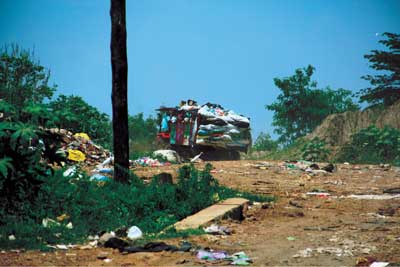
“Over the past years, fires were reported in various dump sites, including Meethotamulla. However, at the Karadiyana dump site there have been no fires to date, as we have taken all necessary precautions to allow the safe degradation of waste. We have installed a network of tubes to allow the gases within the landfill to be released, so that no chemical reaction occurs within. There is also a well-maintained drainage system here that ensures proper drainage during rains and a sawdust barrier surrounding the dump site that ensures there are no landslides,” Wijeratne elaborated.
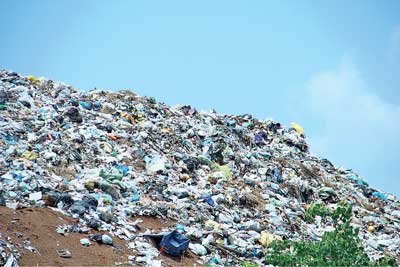
Segregation rendered a futile exercise
When questioned about the segregation of waste that is dumped at the Karadiyana site, Wijeratne pointed out that even though waste was segregated, the waste material that ended up in the landfill was not. “We have a composting site for the degradable waste we receive. Mixed garbage we receive goes to the landfill. A Municipal Council sends us segregated garbage on the allocated days, however we don’t always receive segregated garbage alone. We receive both degradable waste and mixed waste from these provincial bodies, which include both degradable waste and other material such as plastic.”
“We can only provide the facility of disposal to these Urban and Municipal councils as part of the Provincial authority. However, we do not engage directly with people as to how waste should be disposed and segregated,” Wijeratne said.
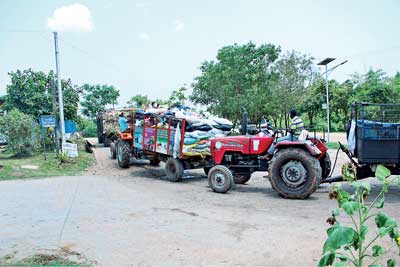
The Karadiyana site carries out a commendable programme of composting, with a daily capacity of 50 metric tonnes of raw waste intake. The final product of the effort is 200 metric tonnes per month. Wijeratne says that plans are underway to develop these mechanisms further.
Area residents, project officers and government officials including Pradeshiya Sabha officials and Municipal and Urban Council secretaries convene every month as an evaluation committee to engage in inspections and discuss concerns regarding this project. During this meeting, various concerns are discussed and resolved and officials are made to submit a report every month on its progress whenever the case is taken up in court. The CEA meanwhile, also inspects the site regularly and submits reports. Therefore, community engagement is seen with the relevant stakeholders of the Karadiyana project. However, a lack of a management by the relevant authorities has rendered all efforts to implement a reduction of waste futile.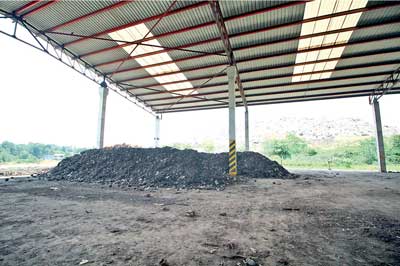

Add comment
Comments will be edited (grammar, spelling and slang) and authorized at the discretion of Daily Mirror online. The website also has the right not to publish selected comments.
Reply To:
Name - Reply Comment
US authorities are currently reviewing the manifest of every cargo aboard MV
On March 26, a couple arriving from Thailand was arrested with 88 live animal
According to villagers from Naula-Moragolla out of 105 families 80 can afford
Is the situation in Sri Lanka so grim that locals harbour hope that they coul